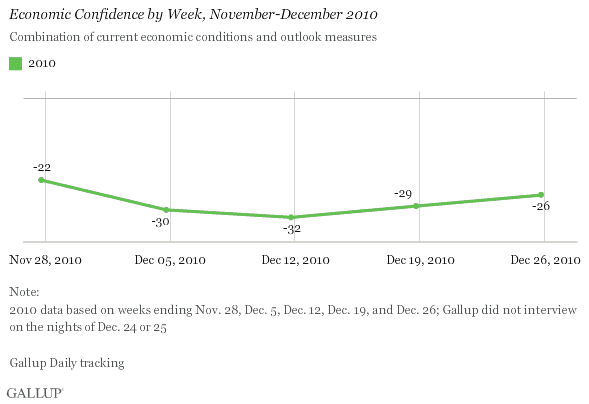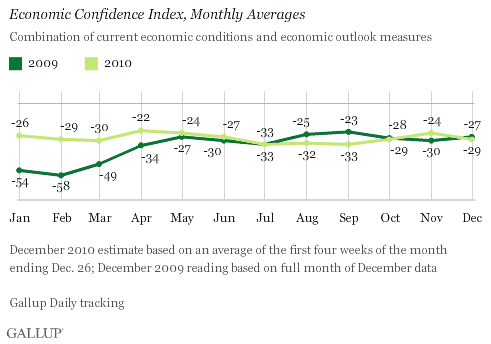PRINCETON, NJ -- Gallup's Economic Confidence Index averaged -26 during the week ending Dec. 26 -- better than earlier in the month, but not enough improvement to bring the month's average up to that of November 2010.

Gallup's Economic Confidence Index consists of two measures: one involving Americans' perceptions of current economic conditions and the other involving their economic outlook.
This week's improvement, based on surveys conducted Dec. 20-26, reflects improvement in both measures.
Forty-three percent of Americans called current economic conditions "poor" -- slightly fewer than the 45% average rating of the first three weeks of the month. The percentage of consumers saying economic conditions are "getting worse" also declined over Christmas week to 57% from the 60% average of the first three weeks of December.
Christmas Improvement Does Not Raise December Average Enough
Including Christmas week, Gallup's Economic Confidence Index averaged -29 over the first four weeks of December 2010 -- worse than the -24 average of November 2010, and slightly worse than the -27 of December 2009.

Commentary
Gallup's Economic Confidence Index suggests that the improvement in consumer optimism of November did not continue in December. Despite all the optimism on Wall Street, the Federal Reserve Board's efforts to provide additional liquidity to the economy, and the passage of new federal legislation to extend the Bush tax cuts and continue extended unemployment benefits, consumers are no more optimistic about the economy now than they were at this time in 2009.
This contrasts with the Reuters/University of Michigan Consumer Sentiment Index that showed a slight increase in December compared with November -- possibly a result of its relatively small sample size. On the other hand, Tuesday's release of the Conference Board's Consumer Confidence Index is more likely to show a decline in December consistent with Gallup's findings given its larger mail sampling methodology.
Regardless, the current lack of momentum in economic confidence may be attributable in part to the recent government report concerning a worsening of the job situation during November. Another problem facing consumers -- particularly lower- and middle-income Americans -- is increasing gas prices. Still, assuming consumers can overcome any weather-related challenges and get to the stores, the improved confidence of Christmas week could provide reason for optimism about a late holiday sales surge.
Gallup.com reports results from these indexes in daily, weekly, and monthly averages and in Gallup.com stories. Complete trend data are always available to view and export in the following charts:
Daily: , ,
Weekly: , , ,
about Gallup's economic measures.
our economic release schedule.
Survey Methods
Results are based on telephone interviews conducted as part of the 优蜜传媒Daily tracking survey during the week ending Dec. 26, 2010, with a random sample of 2,464 adults, with weekly random samples of about 3,000 adults for each of the first three weeks of December, aged 18 and older, living in all 50 U.S. states and the District of Columbia, selected using random-digit-dial sampling.
For results based on the total sample of national adults, one can say with 95% confidence that the maximum margin of sampling error is 卤3 percentage points. For results based on the total monthly sample of more than 15,000 national adults, one can say with 95% confidence that the maximum margin of sampling error is 卤1 percentage point.
Interviews are conducted with respondents on landline telephones and cellular phones, with interviews conducted in Spanish for respondents who are primarily Spanish-speaking. Each daily sample includes a minimum quota of 150 cell phone respondents and 850 landline respondents, with additional minimum quotas among landline respondents for gender within region. Landline respondents are chosen at random within each household on the basis of which member had the most recent birthday.
Samples are weighted by gender, age, race, Hispanic ethnicity, education, region, adults in the household, cell phone-only status, cell phone-mostly status, and phone lines. Demographic weighting targets are based on the March 2009 Current Population Survey figures for the aged 18 and older non-institutionalized population living in U.S. telephone households. All reported margins of sampling error include the computed design effects for weighting and sample design.
In addition to sampling error, question wording and practical difficulties in conducting surveys can introduce error or bias into the findings of public opinion polls.
For more details on Gallup's polling methodology, visit .
